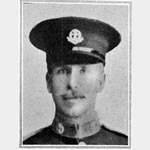Commemorated: | |||
| 1. Memorial: | Royal Irish Rifles Graveyard Laventie | ||
| 2. Book: | The (1921) Masonic Roll of Honour 1914-1918 | Pg.119 | |
| 3. Memorial: | The (1940) Scroll - WW1 Roll of Honour | 12B GQS | |
Awards & Titles: | Queen's South Africa Medal x 4 Clasps King's South African Campaign Medal 1901 & 1902 Clasps | ||
Family :
Husband of Ellen Agnes Cook, of 16, Union Square, New North Rd., Islington, London.Service Life:
Campaigns:
- The South African War 1880-1881, South Africa.
- The First World War 1914-1918, World-wide.
| Unit / Ship / Est.: 2nd Battalion Middlesex Regiment |
2nd Battalion August 1914 : at Malta. Returned to England in September and moved to Hursley Park, attached to 23rd Brigade in 8th Division. 7 November 1914 : landed at Le Havre. |
| Action : The Battle of Neuve Chapelle and subsidiary actions |
Following a winter in the trenches the BEF was prepared to take the offensive against the Germans. The location was Neuve Chapelle, a small village in the front line below Aubers Ridge near Lille. Aubers Ridge was a low but significant hill and the intention at Neuve Chappell was to punch through the German front line, occupy the ridge and exploit with cavalry. It was a battle fought by two Corps of the BEF, the Indian Corps and IV Corps both largely consisting of regular battalions. It was to be preceded by the most violent artillery barrage of the war to date. Unfortunately in what was to be the start of the 'learning curve' for the BEF the artillery barrage, whilst violent, failed in some parts ? a failure that was to be costly and which delayed the assault and allowed the Germans to recover. Whilst the men were exceptionally brave they became bogged down as German machine guns and artillery stopped the momentum of the assault and by the end of the first day (10th March 1915) they were digging in. The following day the assault was repeated with fresh battalions but with no success. By the 12th March the Germans had recovered their poise, had brought in reserves and were ready to counter attack.
Neuve Chapelle (10-12 March 1915) was the first planned offensive battle by the BEF in France and achieved limited tactical success but not the expected breakthrough. It highlighted the problem of delay in execution that allowed the defending Germans to regroup, often consequent on small incidents and errors. Having stabilised the situation following the German sweep into France and the counter attack that eventually established static trench warfare on the western front, there was significant pressure on Britain to take a share of the burden from the French (who had without question had born the brunt of the fighting). Although the battle was effectively over by 12th March, the official battle nomenclature included actions in other sectors up to 22 April 1915 including the significant actions at St Eloi and at Hill 60 (Ypres).
Detail :
A Newspaper Article archived with the Imperial War Museum reads: "2nd LIEUTENANT GEORGE ALBERT COOK, 2nd BATTN. THE DUKE OF CAMBRIDGE'S OWN (MIDDLESEX REGIMENT), who was killed on 10th March, 1915, while leading his men at the Battle of Neuve Chapelle, was born in London, and served in the ranks of the Army for eighteen years. He took part in the South African War, for which he received the Queen's medal with four clasps and the King's medal with two clasps. He was always a studious man, desirous of improving his position and was given his commission, as 2nd Lieutenant, in October, 1914, while serving at the front. 2nd Lieutenant Cook married Ellen Agnes, daughter of Henry Power, and left two children, Ellen Agnes, aged nine, and George Albert aged six."
Masonic :
| Type | Lodge Name and No. | Province/District : |
|---|---|---|
| Mother : | St Ann's No. 593 E.C. | Guernsey & Alderney |
Initiated | Passed | Raised |
10th May 1910 | 14th June 1910 | 12th July 1910 |
Source :
The project globally acknowledges the following as sources of information for research across the whole database:
- The Commonwealth War Graves Commission
- The (UK) National Archives
- Ancestry.co.uk - Genealogy, Family Trees & Family History online
- ugle.org.uk - The records of the United Grand Lodge of England including the Library and Museum of Freemasonry
Additional Source:
- Founder Researchers : Paul Masters & Mike McCarthy
- Researcher : Bruce Littley

